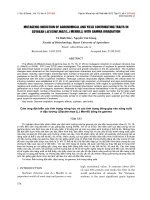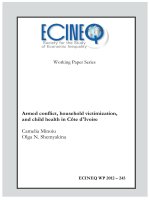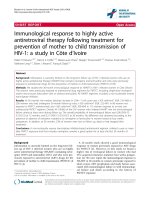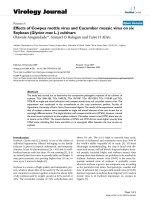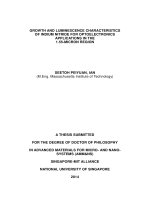Phenotypic and symbiotic diversity of Rhizobia isolated from root nodules of Soybean [Glycine max (L.) Merrill] in Côte D’ivoire
Bạn đang xem bản rút gọn của tài liệu. Xem và tải ngay bản đầy đủ của tài liệu tại đây (529.17 KB, 9 trang )
Int.J.Curr.Microbiol.App.Sci (2019) 8(3): 766-774
International Journal of Current Microbiology and Applied Sciences
ISSN: 2319-7706 Volume 8 Number 03 (2019)
Journal homepage:
Original Research Article
/>
Phenotypic and Symbiotic Diversity of Rhizobia Isolated from Root Nodules
of Soybean [Glycine max (L.) Merrill] in Côte d’Ivoire
Amani Kouadio1, Konate Ibrahim1*, Mako François De Paul N’gbesso2, Attien Yao
Paul1, Lassina Fondio2, Abdelkarim Filali-Maltouf3 and Tidou Abiba Sanogo1
1
UFR Agro-forestry and Environment, Department of Biochemistry and Microbiology,
Laboratory of Agrovalorization, Jean Lorougnon Guede University,
B.P: 150 Daloa, Côte d’Ivoire
2
National Center for Agronomic Research (CNRA), 01 BP 633 Bouaké 01, Côte d’Ivoire
3
Faculty of Sciences, Laboratory of Microbiology and Molecular Biology, University
Mohammed V-Agdal, Rabat, Morocco
*Corresponding author
ABSTRACT
Keywords
Rhizobia, Soybean,
Native strains,
Selection,
Côte d’Ivoire
Article Info
Accepted:
07 February 2019
Available Online:
10 March 2019
Soybean [Glycine max (L.) Merrill] is a legume known for nitrogen fixation interacting
with efficient Bradyrhizobium strains. In Côte d'Ivoire, the Bradyrhizobium inoculums
used in soybean production is a foreign strain, which requires the search for indigenous
strains adapted to Ivorian soils. The present study aimed to isolate and select rhizobial
bacteria from soybeans grown on soils sampled from six localities in the central-western
region of Côte d'Ivoire. Thirty bacteria were obtained from the nodules of plants grown on
soils of two localities that had previously received soybean cultivation (Gonate North and
South). These isolates were coded as RSC and identified as being able to genus
Bradyrhizobium (slow growth) and Sinorhizobium (intermediate growth) depending on
cultural and morphological characteristics. Except for RSC 327 and RSC 330, all isolates
were authenticated and were able to nodulate the host plant in controlled culture. The
isolates RSC 309, RSC 310, RSC 312, RSC 323, RSC 324, RSC 325 and RSC 326 were
efficient and significantly (P <5%) increased the number and weight of the nodules, the
height and plant biomass. Moreover, these same isolates also showed a high tolerance to
salt (NaCl) added in YEM media at a concentration ranging from 4 to 5%. Based on the
symbiotic and physiological characteristics, isolates RSC 309, RSC 310, RSC 312, RSC
323, RSC 324 and RSC 325 could be recommended as the native soybean inoculums under
soil and climatic conditions of Côte d’Ivoire.
Introduction
Nitrogen is an essential nutrient for plant
growth and development. Much of this
nitrogen is provided to cropping systems in
the form of industrially produced nitrogen
fertilizers. However, using of fertilizers has
become detrimental for soil fertility and led to
766
Int.J.Curr.Microbiol.App.Sci (2019) 8(3): 766-774
worldwide ecological problems as well as
affects the human health (Vitousek, 1997;
Yusuf et al., 2009). Thus, maintaining and
increasing soil fertility through Biological
Nitrogen Fixation (BNF) are the major
agricultural priorities in many parts of
countries development. BNF is the cheapest
and ecologic way in which micro-organisms
interacting with leguminous plants such as
soybean [Glycine max (L.) Merrill] fix aerobic
nitrogen (Franche et al., 2009).
Soybean is a legume cultivated for seeds
which are highly rich in protein (40 %) and oil
(20 %) (Nyabyenda, 2005; Cahuzac-Picaud,
2010). Many leguminous crops provide some
protein, but soybean is the only available crop
that provides an inexpensive and high quality
source of protein comparable to meat, poultry
and eggs. It also provides useful crop residues
for animal feed or left in the field to
decompose, thereby increasing the organic
matter content of the soil (Mahamood et al.,
2009). On a global scale, the average yearly
amount of nitrogen fixed by Bradyrhizobium
japonicum is about 450 kg nitrogen ha-1 in a
soybean crop, representing about 90 % of the
nitrogen
requirement
(Giller,
2001;
Zablotowicz and Reddy, 2004). Maintaining
this significant nitrogen input can be important
for economically sustainable soybean yields,
especially in soils containing low available
soil nitrogen (Klubeck et al., 1988;
Zablotowicz and Reddy, 2004). This capacity
of soybean to fix nitrogen reduces the need to
supply crops with synthetic nitrogen
fertilizers.
In Côte d’Ivoire, attempts have been made to
conduct research on soybean growth and
production. However, the studies have focused
solely
on
evaluating
the
effective
compatibility of soybean varieties with the
Bradyrhizobium japonicum (IRAT FA3)
provided by France for two decades for
inoculums production (N'Gbesso et al., 2010).
Recent results from these studies have shown
differences in efficacy between B. japonicum
strain IRAT FA3 and introduced soybean
genotypes in the country (N'Zi et al., 2015;
N'Gbesso et al., 2017). In addition, there is
little information available on native
symbionts of soybeans. Thus, to obtain highly
effective symbiotic soybean bacteria, it is
necessary to search for native Bradyrhizobium
in the laboratory and in greenhouse
conditions. Hence, the objective of our
investigation is to isolate and evaluate the
symbiotic efficacy of soybean Bradyrhizobium
sp from Côte d’Ivoire.
Materials and Methods
The study was conducted on greenhouse in
Jean Lorougnon Guédé University (Daloa,
Côte
d’Ivoire)
experimental
site
(6°54’27.37’’N; 6°26’11.26’’W) in 20172018. The soybean [Glycine max (L.) Merrill]
cultivar Piramama was used for the isolates
trapping and authentication tests.
Soil sampling and Rhizobia trapping
Soil samples were collected from six localities
in Daloa area in the fields which soybean and
over leguminous were previously growing in
the three latest year (Table 1). Sampling was
done following the procedure outlined by
Barker and Pilbean (2007). Soil samples were
randomly collected from several places at 0-20
cm depth from each plot and they were placed
in pots (4 Kg/pot) previously disinfected by
sodium hypochlorite. Pots were arranged in a
completed randomly block design in
greenhouse with five repetitions.
Isolation
and
morphological
characterization of soybean Rhizobia
The Rhizobia were isolated from sterile
nodules and purified with the protocol using
Yeast Extract Mannitol (YEM) agar supplied
767
Int.J.Curr.Microbiol.App.Sci (2019) 8(3): 766-774
with 0.02 % Congo red (Vincent, 1970). At
the harvest, soybean root nodules were
washed first by water and then immersed in
0.1 % acidified HgCl2 for 5 minutes. The
nodules were transferred in a beaker
containing 10 ml of 95 % ethanol for 2-3
minutes. The nodules were rinsed in 6 changes
of sterile water and each nodule was
transferred in hemolysis tube containing 1 ml
sterilized distilled water. Each nodule was
crushed with sterile glass rod. The aliquot of
the suspension was transferred on YEM agar
plate. The plates were incubated at 28 ºC for
4-7 days. Some characteristics colony,
morphology and gram staining properties were
observed.
Confirmation of isolated Rhizobia through
nodulation test
The nodulation capacity of the bacteria
isolated from soybean was confirmed by
inoculation tests on sterile sand. Each isolate
was grown on YEM liquid medium to
exponential phase. Seeds of soybean cultivar
Piramama were surface-sterilized as before
and sown on plastic pots containing sterile
sand. Seven days after sowing, each plant of a
pot except the controls was inoculated by 1 ml
of broth culture of each isolate. Control pots
were included for an unfertilized and an
uninoculated negative control (TO) and
uninoculated but nitrogen fertilized (0.05 %
KNO3) positive control (TN). Plants were
supplied with distilled water every two days,
and they were saturated once a week with a
nitrogen-free nutrient solution. Furthermore,
TN control received weekly 0.05 % (w/v)
KNO3 as nitrogen source.
Plants were harvested 45 day after sowing
(DAS), evaluating nodule number, nodule
weight, plant height and biomass weight. The
experiment was statistically laid out with three
replications using randomized black design
(Somasegaran and Hoben, 1994).
Physiological characteristic: Salt tolerance
Salt tolerance was determined on YEM agar
plates containing from 0 to 10 % (w/v) NaCl
concentrations. This test was carried out on
YEM agar plates. Petri dishes containing
defined medium were subdivided into squares
and each square was inoculated with 10 μl of
48 h bacterial YEM broth Konate et al., 2015).
After 7 days of incubation at 28 °C, bacterial
growth was compared to the controls.
Statistical analysis
The data of measured parameters recorded
were pooled together and subjected to
statistical analysis using the STATISTICA
program (7.1). The strains tolerance was
subjected of Chi2 of Pearson test. Plant growth
and nodulation parameters were subjected by
analysis of variance. The difference between
the treatments means were evaluated at 5 %
level of significance using Fisher’s LSD test.
Results and Discussion
Soil sampling and Rhizobia trapping
Analysis of the variance revealed a significant
difference (P <5%) between nodulation and
soils samples provenance. Indeed, soybean
[Glycine max (L.) Merrill] cultivar Piramama
was able to induce nodule formation only on
soils which were previous soybean cultural.
The best nodulation was obtained on Gonate
SODEFOR soil with an average of 38 nodules
per plant (Table 2). However, soils with a
history of cowpea, green gram, groundnuts
and bean cultural have been unable to promote
nodules formation. These observations
indicate that soybean can form nitrogen fixing
nodules only in symbiosis with a very narrow
range of symbionts. These results corroborate
those of Karaboneye (2013), Kumar and
Reddy (2018). According to those authors,
there are very few native rhizobia strains that
768
Int.J.Curr.Microbiol.App.Sci (2019) 8(3): 766-774
are compatible with soybean lines in tropical
soils. Thus, nodules formation on soybean
roots by native rhizobia is closely related to
the cultural history of soils, the cultivated
variety and compatibility between a variety
and the bacterial strain present in the soil
(N'Gbesso et al., 2017).
addition, colonies diameter and generations
times had varied from 1 to 7 mm and 2 to 7
days respectively. Based on these latest,
isolates could belong to the genus
Bradyrhizobium
(slow
growth)
and
Sinorhizobium
(intermediary
growth)
(Sadowasky et al., 1983; Hossain et al., 2012).
Isolation
and
morphological
characterization of soybean Rhizobia
Confirmation and preliminary screening of
soybean Rhizobia effectiveness through
nodulation test
Thirty (30) isolates bacteria were obtained
from the root nodules of soybean grown on
soils from various sites of center-west of Côte
d’Ivoire (Table 3). Isolates obtained in this
study were coded RSC (Rhizobia isolated
from Soybean in Côte d’Ivoire) and were
generally circular, mucilaginous, pink or white
color on YEM agar medium. Microscopic
examination revealed that all isolates were rod
shaped and gram negative. Similar
characteristics were observed by over authors
on isolates of soybean root nodules in several
parts of the world (Sharma et al., 2010;
Jadhav, 2013; Kapembwa et al., 2016). These
characteristics have been described by Jordan
(1982) as distinctive features of Rhizobia. In
All isolates bacteria, except RSC 327 and RSC
330 were authenticated as soybean symbiont
(Table 3). Therefore, authentic isolates
showed a large diversity in their capacity to
infect the host plant and to improve plant
growth.
Isolates influenced significantly (P <5%)
number and weight of nodules. Isolates RSC
325 and RSC 309 produced the highest
number of nodules (39 and 42.33 plant-1
respectively) (Figure 1). Isolates RSC 323 and
RSC 309 induced the highest weight of
nodules 423.33 mg and 446.67 mg
respectively).
Table.1 Soils sampling origin and cultural history
Sampling area
Geographical Coordinates
Cultural history
Daloa
Bribouo
6°54’31.76’’N ; 6°26’14.99’’W
6°52’22.12’’N ; 6°30’11.96’’W
greengram
cowpea
Gbetitapea
6°47’31.35’’N ; 6°27’7.84’’W
groundnuts
Gonate SODEFOR
6°53’59.14’’N ; 6°10’54.89’’W
Soybean
Gonate North
6°55’36.59’’N; 6°15’31.76’’W
Tapeguhe
6°57’25.48’’N; 6°28’22.69’’W
Soybean
Common bean
Table.2 Nodules means number according to soils origin
Soil sampling sites
Nodules number
Bribouo Daloa
0
0
Gbetitapea Gonate N
0
07±2
N = North; S = South
769
Gonate S
38±4
Tapeguhe
0
Int.J.Curr.Microbiol.App.Sci (2019) 8(3): 766-774
Table.3 Effect of native soybean root nodule isolates on nodule number, nodule weight, plant
height and biomass of soybean on sand pot
Treatment
RSC 301
RSC 302
RSC 303
RSC 304
RSC 305
RSC 307
RSC 308
RSC 309
RSC 310
RSC 312
RSC 313
RSC 314
RSC 315
RSC 316
RSC 317
RSC 318
RSC 319
RSC 320
RSC 321
RSC 322
RSC 323
RSC 324
RSC 325
RSC 326
RSC 327
RSC 328
RSC 329
RSC 330
RSC 331
TN
TNN
LSD (5
%)
Nodule
number
10.67f
3.33g
4g
5.33g
3.33g
3.67g
4g
42.33a
38b
27d
10f
7.33fg
6.67fg
3.33g
3.67g
20.33e
7.33fg
6g
4.33g
7.66fg
38b
31.67c
39.00b
11f
7.33fg
5.67g
10.66f
4.33
nodule weight
(mg plant-1)
83.33fg
53.33g
61g
68.33g
46.67g
51.66g
40g
446.67a
403.33b
380c
86.67fg
81.67fg
66.67g
53.33g
58.33g
261.67d
96.67fg
70g
51.66g
93.33fg
423.33ab
390bc
408.33b
140e
83.33fg
76.67g
113.33ef
34.33
plant height
(cm)
Fresh biomass
(g plant-1)
Dry biomass
(g plant-1)
31.33ab
5.52cde
1.07de
16.33d
5.15de
1.05e
17.8d
5.43de
1.36cde
26.67c
6.13de
1.22de
26c
4.50de
0.86e
30bc
6.70bc
1.22de
27.67c
7.06bc
1.25de
37.23a
7.82ab
2.11a
32.26ab
7.07bc
1.88b
27.80c
6.32cd
1.48cd
28bc
5.12de
1.05e
29bc
6.52c
1.33cde
29.67bc
6.77bc
1.33cde
27c
5.47de
1.21de
27.5c
5.77cd
1.35cde
32.33ab
8.2a
2.97a
24.33c
5.55cd
1.22de
26.67c
4.9de
0.92e
28.73bc
5.24de
1.09de
31ab
6.06cd
1.24de
34.57ab
7.51ab
1.96b
30.67ab
7.50ab
2.01b
33.67ab
7. 79ab
1.94b
31.1ab
6.13cd
1.77bc
27.90c
6.03cd
1.35cde
27.80c
5.58cd
1.26de
28.67bc
6.62c
1.33cde
27.90c
5.92cd
1.19de
29bc
5.72cd
1.07de
30.50bc
7.07bc
1.73bc
25.33c
4.62e
0.86e
6.58
0.8
0.42
In the column, means followed by the same letter did not differ significantly at 5 % level by the LSD test.
TN: uninoculated and fertilized control; T0: uninoculated and unfertilized control.
770
Int.J.Curr.Microbiol.App.Sci (2019) 8(3): 766-774
Table.4 Tolerance of soybean Rhizobia to different concentrations of NaCl
Isolates
RSC 301
RSC 302
RSC 303
RSC 304
RSC 305
RSC 307
RSC 308
RSC 309
RSC 310
RSC 312
RSC 313
RSC 314
RSC 315
RSC 316
RSC 317
RSC 318
RSC 319
RSC 320
RSC 321
RSC 322
RSC 323
RSC 324
RSC 325
RSC 326
RSC 327
RSC 328
RSC 329
RSC 330
RSC 331
0%
3+
3+
3+
3+
3+
3+
3+
3+
3+
3+
3+
3+
3+
3+
3+
3+
3+
3+
3+
3+
3+
3+
3+
3+
3+
3+
3+
3+
3+
0.5 %
2+
2+
2+
2+
2+
2+
2+
2+
2+
2+
2+
2+
2+
2+
2+
2+
2+
2+
2+
2+
2+
2+
2+
2+
2+
2+
2+
2+
2+
1%
2+
2+
2+
2+
2+
2+
2+
2+
2+
2+
2+
2+
2+
2+
2+
2+
2+
2+
2+
2+
2+
2+
2+
2+
2+
2+
2+
2+
2+
1.5 %
1+
2+
2+
2+
2+
2+
2+
2+
2+
2+
2+
2+
2+
2+
2+
2+
2+
2+
2+
2+
2+
2+
2+
2+
2+
2+
2+
2+
2+
Salt tolerance
2%
3%
1+
1+
1+
1+
1+
1+
1+
1+
1+
1+
1+
1+
1+
1+
1+
1+
1+
1+
1+
1+
1+
1+
1+
1+
1+
1+
1+
1+
1+
1+
1+
1+
1+
1+
1+
1+
1+
-
4%
1+
1+
1+
1+
1+
1+
-
5%
1+
1+
1+
-
8%
1+
-
10%
1+
-
3+: Very good growth; 2+: Good growth; 1+: moderate growth; -: no growth
Fig.1 Soybean cultivar Piramama plants inoculated by the isolates RSC 309 (A) and RSC 325
(B) and the uninoculated plants (C)
B
A
Considering the growth of plants, the results
revealed that all
isolates produced
C
significantly higher biomass and plant height
compared to negative control (T0). TheC
higher
B
771
Int.J.Curr.Microbiol.App.Sci (2019) 8(3): 766-774
biomasses were recorded by the isolates RSC
318 (2.97 g) and RSC 309 (2.11 g). The
isolates RSC 310, RSC 323, RSC 324 and
RSC 326 were found statistically similar and
stimulated plant growth than synthetic
nitrogen (KNO3) applied on positive control
(TN). The lowest was found in negative
control and isolates RSC 305 and RSC 320.
These observations are in agreement with
previous reports by N’Gbesso et al., (2017)
on inoculation of over soybean cultivars with
native selected Bradyrhizobium strains, which
showed increased survival percentage in
seedlings and greater biomass production in
all inoculated plant. Some researchers
attributed the higher nodulation and biomass
yields of inoculated plants to high nitrogen
fixation
incorporated
into
nitrogen
biosynthesis (Sharma et al., 2000; Hossain et
al., 2012).
In conclusion, this study clearly reveals that
the soils of Côte d'Ivoire are very poor in
rhizobia, which nodules of the soybean
[Glycine max (L.) Merrill], a legume
introduced in 1970. However, the soils that
have previously received the cultivation of
this legume could generate compatible
rhizobia. In fact, thirty rhizobia were isolated
from the nodules of the soybean Piramama
cultivar in the soils of two localities in Côte
d'Ivoire (center-west). More than 93 % of the
isolates were authenticated, capable of
nodulating the host plant and very close to
Bradyrhizobium
and
Sinorhizobium.
Symbiotic and physiological data showed that
isolates RSC309, SRC310, RSC312, RSC323,
RSC324 and RSC325 were particularly
infectious, efficient and salt-tolerant at 4-5%
of NaCl. These six isolates have promising
symbiotic and agronomic traits and could be
recommended as native inoculants for the
biological inoculation of soybeans under soil
and climatic conditions in Côte d'Ivoire.
Physiological characteristic: salt tolerance
Isolates exhibited a wide tolerance to salt
stress (Table 4). All isolates grew on the
YEM agar medium containing up 2 % of
NaCl excepted isolate BSC 301. Beyond this
concentration, the percentage of tolerant
strains decreased rapidly. Only 26 % of
strains supported 3 % of salt concentrations.
Of these, isolates RSC 309, RSC 324 and
RSC 325 tolerated 4 % NaCl while RSC 312
and RSC 323 showed tolerant to 5% NaCl.
Isolate RSC 310 exhibited the highest
tolerance of salt (10 %). Thus, the salt
inhibitory concentrations varied among
strains.
References
Cahuzac-Picaud M., 2010. Les huiles
végétales,
intérêt
diététique
et
gastronomique. Phytothérapie, 8:113117.
Chen W. M, Lee T. M., Lam CC and Cheng
CP.
2000.
Characterization
of
halotolerant Rhizobia isolated from root
nodules of Canavalia rosea from
seaside areas. FEMS Microb Eco. 34, 916.
El Hilali I., 2006. La symbiose RhizobiumLupin: Biodiversité des microsymbiotes
et mise en évidence d’une multiinfection nodulaire chez Lupinus luteus.
Thèse de Doctorat d’Etat Es Sciences.
Université Mohammed V. Rabat.
Franche C., Lindstrom K and Elmerich C.,
2009.
Nitrogen
fixing
bacteria
associated with leguminous and nonleguminous plants. Plan Soil. 321: 35-
This finding corroborated previous reports
which stipulated that Rhizobia could grow up
to 3 % of salt concentrations (Chen et al.,
2000; Raza et al., 2001; El Hilali, 2006).
However, over work showed that Rhizobia
tolerate low salt concentrations (Zerhari et al.,
2000; Maâtallah et al., 2002).
772
Int.J.Curr.Microbiol.App.Sci (2019) 8(3): 766-774
59.
Giller K.E., 2001. Nitrogen fixation in
tropical cropping systems. Second ed.
CABI Publishing. Wallingford, UK,
448 p.
Hossain A. K. M. M., Mian M. H., Hakim M.
A., Islam M. M. and Ferdous J., 2012.
Isolation
and
selection
of
Bradyrhizobium from the root nodules
of indigo plants (Indigofera tinctoria
L.). Afr. J. Biotechnol. 11(58): 1218312191.
Ibrahim Konate, Adama Ouattara, Bakary
Coulibaly, Raissa N.K. Guei, Kouadio
Amani,
Kpandji
I.
Kouadio,
Abdelkarim
Filali-Maltouf
and
Mathurin KOFFI. (2015). Phenotypic
Diversity of Associative Bacteria
Isolated from Roots and Stems of Cacao
(Theobroma cacao) Tree in Daloa, Côte
d’Ivoire. Int. J. Curr. Microbiol. App.
Sci. 4(9): 560-570.
Jadhav R N., 2013. Isolation of rhizobia from
soybean cultivated in latur area and
study of its phosphate solubilization
activity. Biosci. Disc., 4(1):100-103.
Jordan D.C., 1982. Transfer of Rhizobium
japonicum
Buchanan
1980
to
Bradyrhizobium gen. nov. a genus of
slow-growing root nodule bacteria from
leguminous plants. Int. J. Syst.
Bacteriol. 32: 136–139.
Kapembwa R., Mweetwa A M., Ngulube M.
and Yengwe J. 2016. Morphological
and Biochemical Characterization of
Soybean
Nodulating
Rhizobia
Indigenous to Zambia. Sustainable
Agriculture Research. 5(3): 84-92.
Karaboneye F. 2013. Caractérisation de
l’efficacité symbiotique des lignées
africaines de soja à haute promiscuité.
Mémoire de Maîtrise en Biologie.
Université de Laval, Québec, Canada
123p.
Klubeck B.P., Hendrickson L.L., Zablotowicz
R.M., Skwara J.E., Varsa E.C., Smith
S., Isleib T.G., Maya J., Valdes M.,
Dazzo F.B., Todd R.L. and Walgenback
D.D., 1988. Competitiveness of selected
Bradyrhizobium japonicum strains in
midwestern USA soils. Soil Science
Society of America Journal, 52: 662666.
Maâtallah J., Berraho E.B., Munoz S.,
Sanjuan J and Lluch C., 2002.
Phenotypic characterization of rhizobia
isolated from chickpea (Cicer arietinum
L.) growing in Moroccan soils.
Agronomie. 22, 321-329.
Mahamood J. Abayomi, Y.A. and Aduloju,
M.O. 2009. Comparative growth and
grain yield responses of soybean
genotypes to phosphorous fertilizer
application.
African
Journal
of
Biotechnology 8 (6): 1030-1036.
N’Gbesso M.F.D.P., Fondio L., Coulibaly
N.D and Kouame N.C., 2017. Efficacité
symbiotique de cinq souches locales de
rhizobiums sur les paramètres de
croissance du soja. Inter. J. of Biol. and
Chemic. Scie, 11(5): 2327-2340.
N’Gbesso M.F.D.P., N’guetta ASP, Kouamé
NC and Foua B.K., 2010. Evaluation de
l’efficience de l’inoculation des
semences chez 11 génotypes de soja
(Glycine max L. Merrill) en zone de
savane de Côte d’Ivoire. Sci. Nat.
7(1):59-67.
N’Zi J-C., Koua A P., Kouassi K. D., Kahia
J., Kouassi J-L., N’Guetta A. S-P and
Kouamé C., 2015. Effect of inoculating
seeds with Bradyrhizobium japonicum
on the agronomic performance of five
varieties of soybean (Glycine max) in
Côte d’Ivoire. Afr. J. Agric. Res. 10(37):
3671-3677.
Naveen Kumar, R., Subhash and Reddy, R.
2018. Screening of Bradyrhizobial
Isolates for Plant Growth Promoting
Properties in vitro Conditions. Int. J.
Curr. Microbiol. App. Sci. 7(10): 22322237.
773
Int.J.Curr.Microbiol.App.Sci (2019) 8(3): 766-774
Nyabyenda P., 2005. Les plantes cultivées en
régions tropicales d'altitude d'Afrique:
généralités, légumineuses alimentaires,
plantes racines et tubercules et céréales.
Presses agronomiques de Gembloux.
Belgique. 223 p.
Raza S., Jornsgard B., H. Abou-Taleb and J.
L. Christiansen. 2001. Tolerance of
Bradyrhizobium sp. (Lupini) strains to
salinity, pH, CaCO3 and antibiotics.
Lett. Appl. Microbiol. 32, 379-83.
Sadowsky M. J., Keyser H. H and Bohlool, B.
B., 1983. Biochemical Characterization
of Fast- and Slow-Growing Rhizobia
that Nodulate Soybeans. Int. J. of
Systematic Bacteriology, 33(4), 716722.
Sharma M. P., Srivastava K and Sharma S.
K., 2010. Biochemical characterization
and metabolic diversity of soybean
rhizobia isolated from Malwa region of
Central
India.
Plant
Soil
&
Environment, 56(8), 375-383.
Sharma S., Upadhyay R.G. and Sharma C.R.
2000. Effect of Rhizobium inoculation
and nitrogen on growth, dry matter
accumulation and yield of black gram
(Vigna mungo). Legume Resaerch,
23(1): 64-66.
Somasegaran P and Hoben H. J., 1994.
Handbook for Rhizobia Methods in
LegumeRhizobium
Technology,
springer Verlag, New York, USA. pp.
58-101.
Vincent J.M., 1970. A manual for the
practical study of root-nodule bacteria.
Blackwell Scientific, Oxford, UK.
Vitosh M. L., 1997. Soybean inoculation in
Michigan. Soybean Facts Winter,
Department of Crop and Soil Sciences,
Michigan State University, USA. 4p.
Yusuf N., Nasti T.H and Meleth S., 2009.
Resveratrol enhances cell-mediated
immune response to DMBA through
TLR4
and
prevents
cutaneous
carcinogenesis. In cooperation with the
University of Texas MD Anderson
Cancer Center 48 (8): 713-723.
Zablotowicz, R. M. and Reddy K. N., 2004.
Impact of Glyphosate on the
Bradyrhizobium japonicum symbiosis
with Glyphosate-resistant transgenic
soybean: a minireview. J. Envir.Quality.
33: 825-831.
Zerhari K., Aurag J., Khbaya B., Kharchaf D
and Filali-Maltouf A., 2000. Phenotypic
characteristics of rhizobia isolates
nodulating Acacia species in the arid
and Saharan regions of Morocco. Lett.
Appl. Microbiol. 30, 351-357.
How to cite this article:
Amani Kouadio, Konate Ibrahim, Mako François De Paul N’gbesso, Attien Yao Paul, Lassina
Fondio, Abdelkarim Filali-Maltouf and Tidou Abiba Sanogo. 2019. Phenotypic and Symbiotic
Diversity of Rhizobia Isolated from Root Nodules of Soybean [Glycine max (L.) Merrill] in
Côte d’Ivoire. Int.J.Curr.Microbiol.App.Sci. 8(03): 766-774.
doi: />
774
